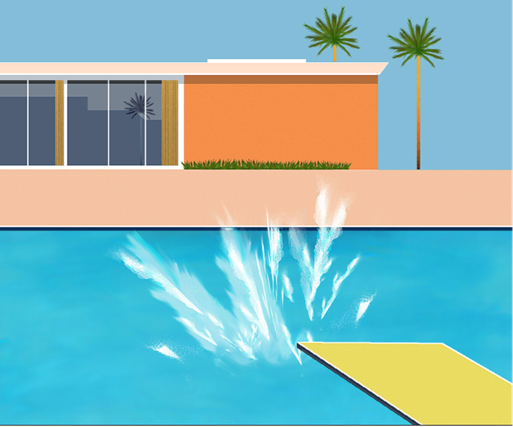Symbolism in Art: Water

English artist David Hockney is known as an important contributor to the pop art movement and is perhaps best recognised for his striking representation of Californian life and architecture in the 1960s.
English artist David Hockney is known as an important contributor to the pop art movement and is perhaps best recognised for his striking representation of Californian life and architecture in the 1960s.
Hockney was born in England in 1937, he studied at the Royal College of Art, experimenting with the expressionist style in his early works, before settling on bright, bold acrylic paintings in the pop art style. Hockney was featured as an one of the first British Pop Artists in the RCA’s Young Contemporaries exhibition, but was refused his diploma after he failed to write an essay as part of his final assessment. He wanted to be judged solely on his artworks. In protest at the decision he painted The Diploma, a satirical version of the official diploma awarded by the institution. The RCA relented, awarding him a real diploma shortly after.
A year after graduating, Hockney visited California for the first time in 1963. He was struck by the lifestyle he saw on the Western coast of the USA and shortly after his visit he began painting a series of swimming pools, inspired by the pools he had seen at people’s houses and hotels. Most of his swimming pool images were painted between 1964 and 1971. His fascination with swimming pools has continued into later life. It is reported that he still swims for half an hour a day. Hockney’s acrylics served him well in this new direction, capturing the dry heat and sun-drenched buildings of California.
Just one year after his first visit to California, Hockney moved to Los Angeles, where he spent 4 years. Hockney once commented that “the climate is sunny, the people are less tense than in New York…When I arrived I had no idea if there was any kind of artistic life ther and that was the least of my worries”.
A Bigger Splash was one of a series of three splash paintings. It was painted in the summer of 1967 whilst Hockney was teaching at the University of California in Berkley. The swimming pool was based on an image Hockney had seen in a book. He contrasted against a 1960s style modernist building, of which he had made several sketches and studies.
Water itself holds a number of symbolic meanings. It is often used as a symbol of purity and tranquillity, but it can also be tempestuous and forbidding, impossible to control and unreliable. In Hockney’s A Bigger Splash we see both elements of water. The pool itself is tranquil and unmoving, an appealing shade of turquoise that looks welcoming and inviting. The splash adds an element of movement and action, an indicator that someone is underneath that water, consumed by it’s blue surface and buried beneath it’s calm exterior.

A Bigger Splash
Water is often associated with the ability to wash away our sins and leave us pure and refreshed. In religious ceremonies, water is often used to purify us, ready for a transformation or new beginning. Unlike in many of Hockney’s paintings, we cannot see the human figure in this image, but we are aware that someone is there. An empty sun chair faces us from the opposite side of the pool, waiting for its occupant but cut off from us and rendered out of reach by the stretch of water that overtakes the painting.
The vibrant blue of the water is reflected in the empty blue sky. Hockney painted most of the picture with flat blocks of colour, reserving his attention for the details of the splash itself. In previous works, Hockney had been at paints to represent the fluidity and motion of water. He used a variety of techniques to represent the dapples of light on the water as it moved. The splash paintings stand out as they present water as a much more stable, solid block, with the exception of the movement created by the splash. The splash is chaotic against the calm and tranquillity of the surrounding landscape.
Hockney’s pool paintings often depict a Californian land of luxury and acceptance – a utopic, anything-goes world where wealthy people luxuriate in their surroundings. But history tells us that at the same moment in history, public pools were experiencing racial segregation and tension. Open homosexuality was still taboo and the push for civil rights was raging.
In A Bigger Splash, Hockney’s swimming pool is calm and serene, although the presence of an unseen human has disturbed the scene, creating a wave of motion and a trail of chaos. The changeable, fluid nature of water is represented in the movement of the splash. That which seems solid and peaceful on the surface is really hiding a multitude of possibilities to erupt into motion or to consume us at any given moment. As Hockney showed when he stood up to the RCA and as Californian society was demonstrating in the 1960’s, human beings are just as reactive and volatile as water. The calm, solid looking surface can hide any number of untold secrets.
